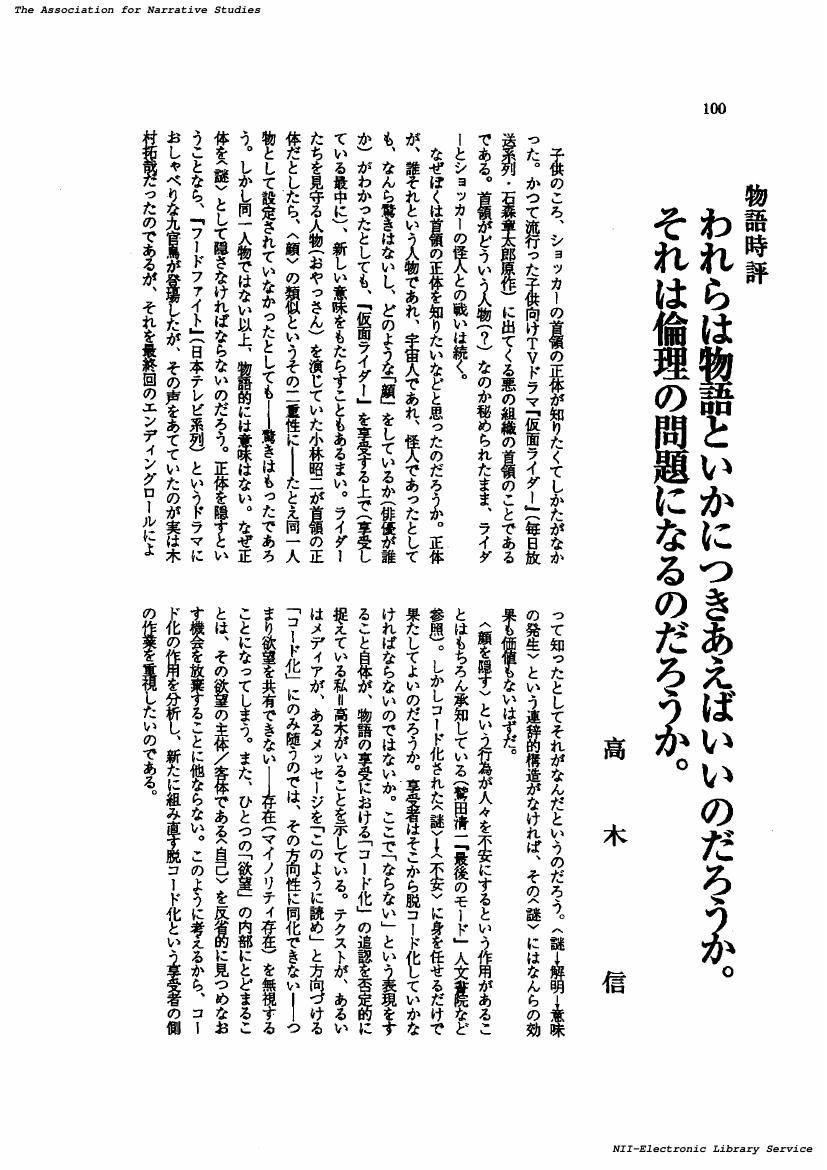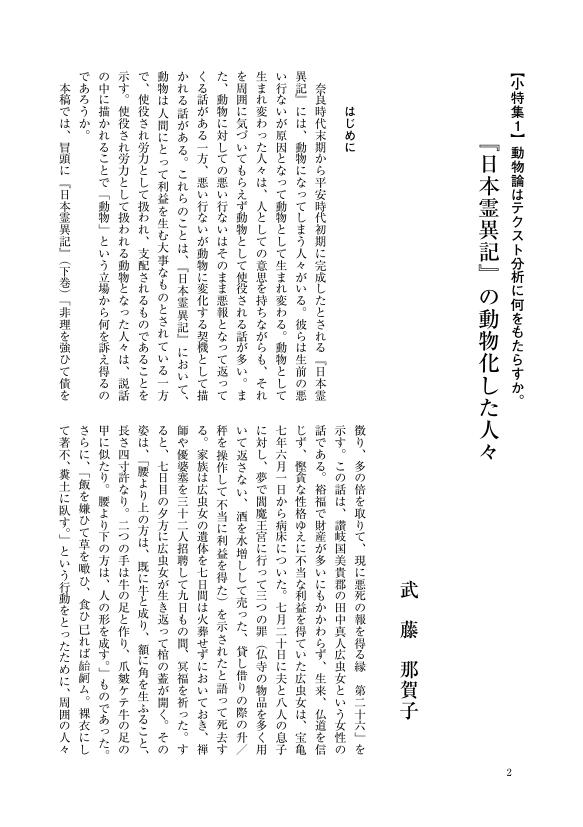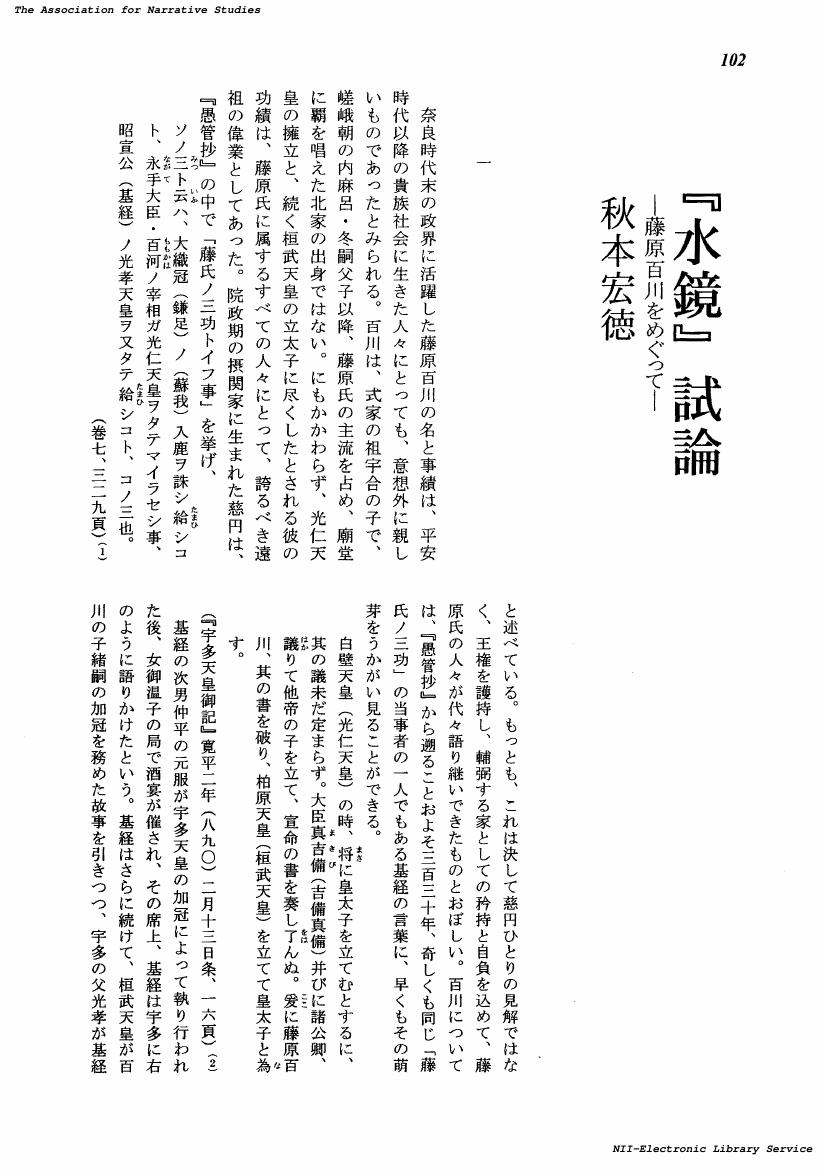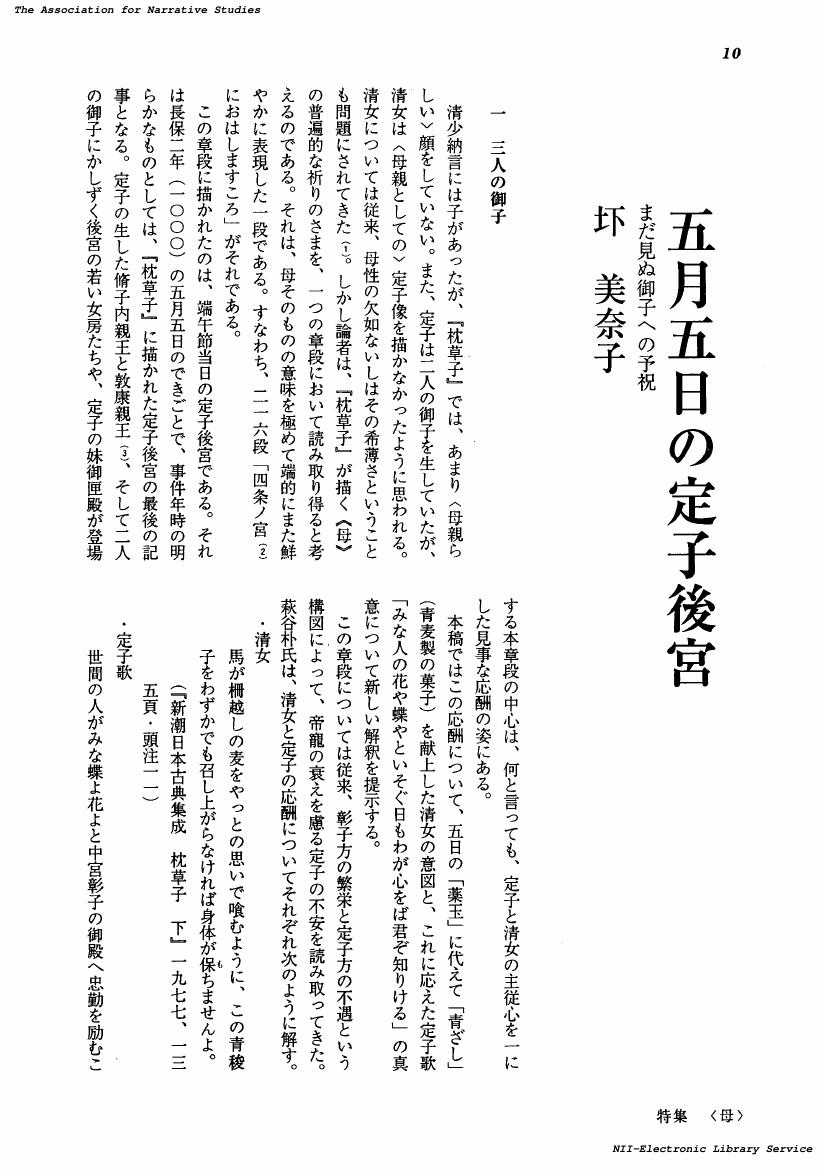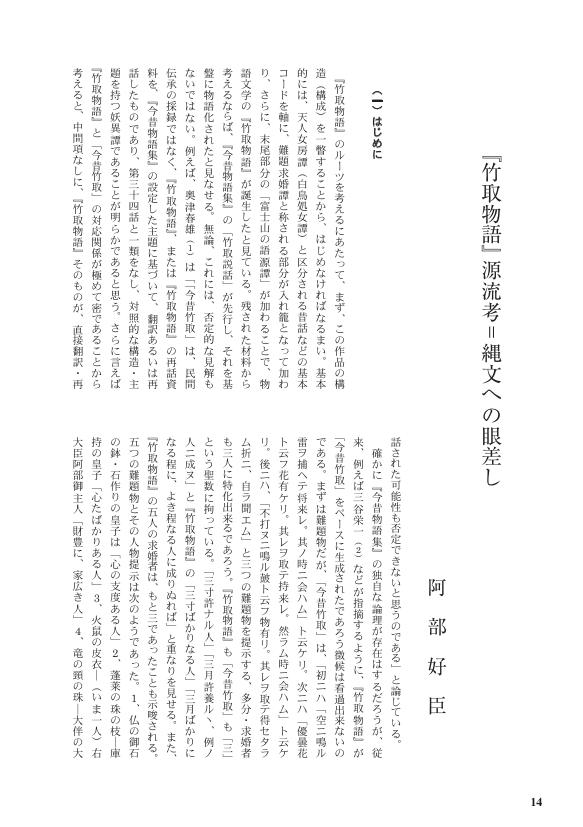2 0 0 0 OA 『源氏物語』 のウズベク語訳の意義と問題―付 「桐壺」 巻試訳― クルボノヴァグルノザ
- 出版者
- 物語研究会
- 雑誌
- 物語研究 (ISSN:13481622)
- 巻号頁・発行日
- vol.18, pp.175-191, 2018 (Released:2021-07-01)
2 0 0 0 OA 物語研究会二〇〇〇年度大会シンポジュウム「区分・領域」(ディスカッサント報告)
- 著者
- 松岡 智之
- 出版者
- 物語研究会
- 雑誌
- 物語研究 (ISSN:13481622)
- 巻号頁・発行日
- vol.1, pp.111-114, 2001-03-30 (Released:2018-03-27)
2 0 0 0 OA 物語研究会一九九九年度大会シンポジュウム「区分・領域」(ディスカッサント報告)
- 著者
- 橋本 ゆかり
- 出版者
- 物語研究会
- 雑誌
- 物語研究 (ISSN:13481622)
- 巻号頁・発行日
- vol.1, pp.106-110, 2001-03-30 (Released:2018-03-27)
- 著者
- 高木 信
- 出版者
- 物語研究会
- 雑誌
- 物語研究 (ISSN:13481622)
- 巻号頁・発行日
- vol.1, pp.100-105, 2001-03-30 (Released:2018-03-27)
- 著者
- 江戸 英雄
- 出版者
- 物語研究会
- 雑誌
- 物語研究 (ISSN:13481622)
- 巻号頁・発行日
- vol.1, pp.33-45, 2001-03-30 (Released:2018-03-27)
2 0 0 0 OA 『日本霊異記』の動物化した人々
- 著者
- 武藤 那賀子
- 出版者
- 物語研究会
- 雑誌
- 物語研究 (ISSN:13481622)
- 巻号頁・発行日
- vol.21, pp.2-15, 2021-03-31 (Released:2022-08-25)
- 著者
- 藤井 貞和
- 出版者
- 物語研究会
- 雑誌
- 物語研究 (ISSN:13481622)
- 巻号頁・発行日
- vol.14, pp.16-27, 2014-03-31 (Released:2018-03-27)
演劇(神事から訣れて成立するにしても)を支えるのはperformativityだ。もの凄い危機的な転換点で、(例えば)人身犠牲からの脱却や(祭祀へ向かうだろう)、戦闘(虐殺、略奪、rape)の擬制化、村や家の起源神話の成立、昔話(口承説話)の簇生、(慰鎮しようがないにせよ)御霊(=亡霊)祭祀の成長……、それらが仮面や舞踏の夜に幻出し、歌謡(詩歌)を、語り(のルール)を、演出(舞台、作り物、俳優、台本、作劇法)をというように、擬態に(木の葉に、枯れ枝に、鳥のうんこに)分化して、芸能を足組みし、演劇へ構築される。物語を支えるすべてのperformativityもまたそこに胚胎しよう。"前"神話紀を措いて、1、神話紀、2、昔話紀、3、フルコト紀、4、物語紀、5、ファンタジー紀、および紀と紀との<間>境域にもの凄い危機が訪れて、文化や文学事象を産むという見渡しである。二〇一三年八月物語研究会大会(於、犬山市)のシンポジウムでの発表原稿に加筆する。
2 0 0 0 OA 『水鏡』試論 : 藤原百川をめぐって(自由論文)
- 著者
- 秋本 宏徳
- 出版者
- 物語研究会
- 雑誌
- 物語研究 (ISSN:13481622)
- 巻号頁・発行日
- vol.4, pp.102-117, 2004-03-31 (Released:2018-03-27)
- 著者
- 内藤 まりこ
- 出版者
- 物語研究会
- 雑誌
- 物語研究 (ISSN:13481622)
- 巻号頁・発行日
- vol.7, pp.1-13, 2007
In this paper by focusing on a topic, Shiga no yamagoe, the author considers the dynamics of medieval poetry. A striking feature of the poems composed on the set topic Shiga no yamagoe in the Roppyakuban utaawase (1193) is that all of them included the phrase "Flower". Previous researchers have argued that there was a strong connection between Shiga no yamagoe and the phrase "Flower" in medieval poetry, even though the reason for this connection remained uncertain. How then did flowers come to be associated with Shiga no yamagoe? The author begins with discussing what led Shiga no Yamagoe to be linked with the idea of flowers. First, the author examines how Fujiwara no Shunzei, the judge of the Roppyakuban utaawase, supported the notion of combining Shiga no yamagoe with spring flowers in poetry composition. Secondly, the author shows how some poems pair flowers with the idea of female pilgrims traveling to Shiga Temple. The author argues that there were narratives about women pilgrims going to Shiga Temple which supported the relationship between Shiga no yamagoe and women. And the author also shows that the actual pilgrimage to Shiga Temple was no longer practiced by Shunzei's time. The author suggests that the association of Shiga no yamagoe with the idea of flowers developed from narratives of female pilgrims set in the past. In addition, the author focuses on a famous place. or utamakura, Shiga no hanazono, which appeared in medieval times for the first time. The author argues that it was a fictional place, which created whereby the topic Shiga no yamagoe came to be associated with flowers.
- 著者
- 陶山 裕有子
- 出版者
- 物語研究会
- 雑誌
- 物語研究 (ISSN:13481622)
- 巻号頁・発行日
- no.9, pp.1-11, 2009-03-31
This study considers the "classic intellect" in the Insei period and discusses historical description within two texts, Okagami and the Imakagami, neither of which cites classic literature. I investigate the "classic intellect" within three waka textbooks: Kokinjochu by Katsumyo, Fukurozoshi, and Toshiyorizuino. In these textbooks, secret poetic principles are written in reference to waka language from Kokinshu, which had already become a "classic" within waka circles. In the Kokinjochu, for example, waka theory is explained in reference to Nihongi, which had nothing to do with waka. Many people in the Insei period collected and put together classic books (books about classical literature?), which is why intellectuals referred frequently to the "classic intellect." This study shows that Okagami and Imakagami, which were written in the same period, did not use the phrase "it was written in" but rather "I heard that it was written in," even if directly using the classics. Further, I show that the narrator of these texts states that anyone, including the illiterate, can understand historical description-a claim which is incompatible with the notion of the "classic intellect" being understandable only by intellectuals.
- 著者
- 西原 志保
- 出版者
- 物語研究会
- 雑誌
- 物語研究 (ISSN:13481622)
- 巻号頁・発行日
- no.21, pp.16-30, 2021-03
2 0 0 0 OA 「独生独死」観の受容と「翻訳」論的問題―中世の孤独と無常をめぐって― 荒木 浩
- 出版者
- 物語研究会
- 雑誌
- 物語研究 (ISSN:13481622)
- 巻号頁・発行日
- vol.18, pp.219-228, 2018 (Released:2021-07-01)
2 0 0 0 OA 五月五日の定子後宮 : まだ見ぬ御子への予祝(<特集>母)
- 著者
- 圷 美奈子
- 出版者
- 物語研究会
- 雑誌
- 物語研究 (ISSN:13481622)
- 巻号頁・発行日
- vol.3, pp.10-25, 2003-03-31 (Released:2018-03-27)
- 著者
- 原 豊二
- 出版者
- 物語研究会
- 雑誌
- 物語研究 (ISSN:13481622)
- 巻号頁・発行日
- vol.8, pp.38-43, 2008
- 著者
- 北條 勝貴
- 出版者
- 物語研究会
- 雑誌
- 物語研究 (ISSN:13481622)
- 巻号頁・発行日
- no.9, pp.20-31, 2009-03-31
In ancient China, it was originally thought that a person who suffered an abnormal death became a demon and committed evil to the living. The general procedure (fashion) in dealing with demons involved solely elimination through a ritual of confrontation, not a religious service. Although sentiments among the people started to upset such customs (traditions), during the Zhanguo Period thereafter, religious practices pertaining to demons became commonalized via national intervention. It was in the bereaved seeking to deliver (redeem) the dead in agony (in anguish) that led to the nation's involvement in addressing those who had undergone an unnatural death. Hence, the more intimate the deceased is to one, man (mankind) cannot help but speak on behalf of the departed. However, those statements after all are plagiarisms of the account of the dead that attempt to preserve (maintain) and reinforce the legitimacy (rights) of the individual and community. Only the very dead can determine the meaning of death ; rather, only can we cultivate (nurture) our sensitivity toward the voices of the expired. In fact, since that in itself is a difficult task that requires the potency of a tough and flexible mind, it may therefore turn into an opportunity to relativize the existing (current) frame of reference.
2 0 0 0 OA 自己の外縁――『源氏物語』における分身と同身―― 西原志保
- 出版者
- 物語研究会
- 雑誌
- 物語研究 (ISSN:13481622)
- 巻号頁・発行日
- vol.16, pp.122, 2016 (Released:2019-04-20)
- 著者
- 西野 厚志
- 出版者
- 物語研究会
- 雑誌
- 物語研究 (ISSN:13481622)
- 巻号頁・発行日
- no.9, pp.45-59, 2009-03-31
Jacques Derrida, a philosopher known for "deconstruction" is said to have made an "ethical turn" after the 1980s. The very declaration of "Deconstruction is Justice" in even the "Force of Law" (1994), was a significant event that clearly illustrated an "ethical turn". At around the same period in time, while Derrida argued against the philosophy of Heidegger in "Of Spirit" (1987), following the "ethical turn", he discusses the term "Geist", a keyword he utilizes in referring to ghostly apparitions which also suggests "spirit". This study disputes the potentials verses the risks of the "ethics" that Derrida presents, in comparing the "Force of Law" and "Of Spirit".
- 著者
- 助川 幸逸郎
- 出版者
- 物語研究会
- 雑誌
- 物語研究 (ISSN:13481622)
- 巻号頁・発行日
- no.11, pp.68-84, 2011-03-31
In 1980s, Consumerism was prevailing in Japan. This brought about a tendency of looking at oneself as a special existence and to think that seeking personal pleasure is more sophisticated than trying to reform the society. These changes strengthened the influence of "OLIVE", which is one of the most popular magazines in 80s, and created the boom of French Theory. Monogatari Kenkyukai, or the Association of Narratology aka Monoken, introduced Textual Analysis as one of the methods to criticize the main stream of academic investigation in the early 70s. But, as with the development of consumer society in 80s, the role of Textual Analysis made a change to provide excuses to cover up the fault of one's own reading. It turned out to be impossible for Monoken to monitor overdoing on the establishment side, as few members of this association could realize that the changes had taken place. Nowadays, study of Japanese Literature has begun to collapse as a system. We, the members of Monoken, should reconsider the meaning of Textual Analysis for rebuilding the narratology up in Japan.
- 著者
- 樋口 大祐
- 出版者
- 物語研究会
- 雑誌
- 物語研究 (ISSN:13481622)
- 巻号頁・発行日
- no.9, pp.32-44, 2009-03-31
This study was spurred by a precedent research by Makoto Takagi et al. and attempts to investigate the affiliations between "borei" (ghostly manifestations) and war chronicles (the interpretation centers around "onryoshikan" or historical insights of vindictive spirits). According to the five literary works (pieces of literature), The Tale of Hogen, The Tale of Heiji, The Tale of Heike, Shokyuki (The account of the Shokyu War), Taiheiki (Chronicle of the Grand Pacification), there are records pertaining to nation-wide famous "onryo" or vengeful ghosts across history such as Sutokuin, Emperor Antoku, Gotobain, and Emperor Daigo etc. However, despite The Tale of Hogen is a fundamental component surrounding the historical insight of the "onryo" or spirit belonging to Sutokuin, according to other sources, we have yet to come up with a rational justification of the many incidents concerning the occurrences of these appearances. While Shokyuki seems indifferent toward the ghost of Gotobain, The Tale of Heike and Taiheiki include "onryoshikan" or historical insights of vindictive spirits, though after all it resorts to other interpretations. On the other hand, since the term "borei" is utilized to express a wider meaning, Tairano Kiyomori's recollection in The Tale of Heike should be linked to current reliable methods (in insinuating that it existed in the past and yet shall continue to prevail in the future) and thus shall provide several perspectives related to "borei" or departed spirts in history.
1 0 0 0 OA 『竹取物語』 源流考=縄文への眼差し 阿部好臣
- 出版者
- 物語研究会
- 雑誌
- 物語研究 (ISSN:13481622)
- 巻号頁・発行日
- vol.18, pp.14-28, 2018 (Released:2021-07-01)



